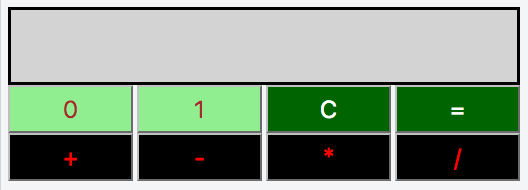Hackerrank | 10 Days of Javascript | Day 9-Solution in JS | Binary-Calculator-Hackerrank-Solution-in-JS
Objective
In this challenge, we implement a calculator that uses binary numbers. Check out the attached tutorial for learning materials.
Task
Implement a simple calculator that performs the following operations on binary numbers: addition, subtraction, multiplication, and division. Note that division operation must be integer division only; for example, , , and .
The calculator's initial state must look like this:

Element IDs. Each element in the document must have an
id, specified below:innerHTMLidDescription/Behavior resContains the result of button presses. btnsA button container that displays all eight calculator buttons. 0btn0A button expressing binary digit . 1btn1A button expressing binary digit . CbtnClrA button to clear the contents of . =btnEqlA button to evaluate the contents of the expression in . +btnSumA button for the addition operation. -btnSubA button for the subtraction operation. *btnMulA button for the multiplication operation. /btnDivA button for the integer division operation. Styling. The document's elements must have the following styles:
bodyhas awidthof33%.reshas abackground-coloroflightgray, aborderthat issolid, aheightof48px, and afont-sizeof20px.btn0andbtn1have abackground-coloroflightgreenand acolorofbrown.btnClrandbtnEqlhave abackground-colorofdarkgreenand acolorofwhite.btnSum,btnSub,btnMul, andbtnDivhave abackground-colorofblack, acolorofred.- All the buttons in
btnshave awidthof25%, aheightof36px, afont-sizeof18px,marginof0px, andfloatvalueleft.
The .js and .css files are in different directories, so use the link tag to provide the CSS file path and the script tag to provide the JS file path:
<!DOCTYPE html>
<html>
<head>
<link rel="stylesheet" href="css/binaryCalculator.css" type="text/css">
</head>
<body>
<script src="js/binaryCalculator.js" type="text/javascript"></script>
</body>
</html>
Constraints
- All expressions in the test dataset are entered in the form , where is the first binary number, is the second binary number, and is in the set .
- Both operands will always be positive integers when converted from base- to base-.
- All expressions will be valid.
Explanation
Consider the following sequence of button clicks:
Before pressing the button, the result div looks like this:

After pressing the button to evaluate our expression, the result div looks like this:

Notice that , , and , so our calculator evaluated the expression correctly.
Now, let's consider our next sequence of button clicks as:
Before pressing the button, the result div looks like this:

After pressing the button to evaluate our expression, the result div looks like this:

Consider the next sequence of button clicks as:
The result div looks like this:

https://www.hackerrank.com/challenges/js10-binary-calculator/problem
Day 9: Binary Calculator Solution in JSbinaryCalculator.cssbody { width: 33%; } #res { display: block; font-size: 20px; height: 48px; background-color: lightgray; border: 2px solid black; box-sizing: border-box; } #btns { display: block; overflow: hidden; } #btns button { display: block; float: left; width: 25%; height: 36px; font-size: 18px; background: black; color: red; } #btns #btn0, #btns #btn1 { background-color: lightgreen; color: brown; } #btns #btnClr, #btns #btnEql { background-color: darkgreen; color: white; }binaryCalculator.jswindow.onload = () => { let inputs = []; let operator = ''; const displayRes = () => { const res = document.getElementById('res'); let val1 = inputs[0]; let val2 = inputs[1] === undefined ? '' : inputs[1]; res.innerText = `${val1}${operator}${val2}`; }; const setOperator = op => { if (inputs[1] === undefined) { operator = op; } displayRes(); }; const setValues = num => { if (inputs.length === 0) { inputs[0] = num; } else if (inputs.length === 1 && operator.length === 0) { inputs[0] += num; } else if (inputs.length === 1 && operator.length > 0) { inputs[1] = num; } else if (inputs.length === 2 && operator.length > 0) { inputs[1] += num; } displayRes(); }; const btn0 = document.getElementById('btn0'); btn0.addEventListener('click', () => { setValues('0'); }); const btn1 = document.getElementById('btn1'); btn1.addEventListener('click', () => { setValues('1'); }); const btnSum = document.getElementById('btnSum'); btnSum.addEventListener('click', () => { setOperator('+'); }); const btnSub = document.getElementById('btnSub'); btnSub.addEventListener('click', () => { setOperator('-'); }); const btnMul = document.getElementById('btnMul'); btnMul.addEventListener('click', () => { setOperator('*'); }); const btnDiv = document.getElementById('btnDiv'); btnDiv.addEventListener('click', () => { setOperator('/'); }); const btnClr = document.getElementById('btnClr'); btnClr.addEventListener('click', () => { inputs = ['']; operator = ''; displayRes(); }); const btnEql = document.getElementById('btnEql'); btnEql.addEventListener('click', () => { if (inputs.length === 2 && operator.length > 0) { let a = parseInt(inputs[0], 2); let b = parseInt(inputs[1], 2); switch (operator) { case '+': inputs = [(a + b).toString(2)]; break; case '-': inputs = [(a - b).toString(2)]; break; case '*': inputs = [parseInt(a * b, 0).toString(2)]; break; case '/': inputs = [parseInt(a / b, 0).toString(2)]; break; } operator = ''; displayRes(); } }); };index.html<html lang="en"> <head> <meta charset="UTF-8"></meta> <meta content="width=device-width, initial-scale=1.0" name="viewport"></meta> <meta content="ie=edge" http-equiv="X-UA-Compatible"></meta> <link href="css/binaryCalculator.css" rel="stylesheet" type="text/css"></link> <title>Day 9: Binary Calculator</title> </head> <body> <div id="res"><div id="btns"> <button id="btn0">0</button>



0 Comments